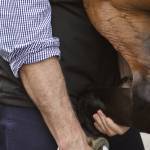Popular Regenerative and Rehabilitation Therapies in Horses

If your horse ever suffers a lameness, an array of regenerative and rehabilitation therapies may be used for treatment. Faced with a preponderance of available choices, from simple hand-walking to stem cell therapy, how do you know which to use when?
“Unfortunately, this question remains to be answered,” shared Laura Petroski-Rose, B.V.M.S., a veterinarian for Kentucky Equine Research. “Despite the welcome growth in regenerative medicine over the past two decades, the field remains in its infancy. We have much to learn regarding selection and application of the various techniques.”
In an attempt to help direct and focus research efforts in the field of regenerative medicine, one group of Oregon veterinarians recently amassed and analyzed data from 305 surveys sent to veterinary facilities.
One goal of the study was to identify popular methods employed in rehabilitation medicine.
According to the veterinary researchers, “Such information is valuable in determining which modalities would benefit most from rigorous assessments of their efficacy and risks, ultimately to improve the burgeoning practice of equine rehabilitation.”
Of 38 different rehabilitation modalities, the most common were:
-
Controlled hand-walking (97.3%);
-
Therapeutic shoeing (96.1%);
-
Ice (95.2%);
-
Compression-bandaging (89.5%);
-
Platelet-rich plasma (PRP; 86.5%);
-
Therapeutic exercises (84.3%);
-
Interleukin-1 receptor antagonist protein therapy (IRAP; 81.4%);
-
Stretching (83.3%); and
-
Cold-water hydrotherapy (82.9%).
Heat (77.6%), massage (69.0%), and acupuncture (68.3%) were also commonly used. Hyperbaric oxygen therapy (9.4%), cytowave (8.3%), and radiofrequency (6.4%) were least commonly used.
“While not all injuries or performance-related musculoskeletal conditions can be avoided completely, owners can take steps to help minimize problems or slow their progression. Kentucky Equine Research offers a myriad of joint supplements that have a protective effect on the development of joint disease,” Petroski-Rose noted. “Those include KER-Flex; a high-molecular weight hyaluronic product called Synovate HA; and EO-3, which contains the natural anti-inflammatory properties of DHA and EPA. Each of these products has proven benefits for horses with osteoarthritis.”
In addition, should your horse require some time off, Kentucky Equine Research developed Triacton, which will help support bone density in athletic horses as well as during times of recovery.
“Triacton contains a variety of bone-building ingredients, including an array of nutrients such as magnesium, boron, silicone, iodine, zinc, and manganese, as well as vitamins A, C, D, and K. All of the ingredients included in Triacton are important for achieving and maintaining bone health,” explained Petroski-Rose.
*Wilson, J.M., E. McKenzie, and K. Duesterdieck-Zellmer. 2018. International survey regarding the use of rehabilitation modalities in horses. Frontiers in Veterinary Science. 5:120.








